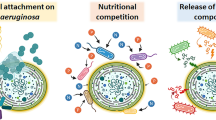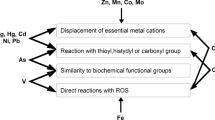Abstract
One hundred and eighteen algal isolates comprising seven classes were obtained from a range of sites from polluted rivers running through Cu or Zn mining regions, and from unpolluted rivers. All the isolates were tested for photosynthetic activity when exposed to Cu, Cd or Zn. The tolerance levels of Bacillariophyceae, Charophyceae, Cyanophyceae and Chlorophyceae to Cu showed significant positive correlations with Cu concentrations in the field. However the distribution of metal sensitivities of the algae from the sites with the same metal concentration was broad. Both Bacillariophyceae and Charophyceae had a number of strains whose sensitivity to Cu differed more widely in relation to Cu levels in the environment than Cyanophyceae and Chlorophyceae. Cyanophyceae were sensitive to all three metals, whether or not isolates were obtained from polluted sites, whereas Chlorophyceae tended to have high tolerance even in isolates from unpolluted sites. For Cd and Zn the correlation between tolerance levels and concentrations in the field was not so clear as for Cu. The occurrence of Cu tolerance was shown in 4 diatom species and one Charophyceae, whereas metal resistance occurred in some Chlorophyceae. Cu-tolerant isolates tended also to be Zn-tolerant in Bacillariophyceae, and Cd-resistant isolates tended also to be Zn-resistant in Chlorophyceae.
Similar content being viewed by others
References
Ettl H (1976) Die GattungChlamydomonas Ehrenberg. Nova Hedw. 49: 1–1122.
Foster PL (1982) Metal resistances of Chlorophyta from rivers polluted by heavy metals. Freshwat. Biol. 12: 41–61.
Geitler L (1932) Cyanophyceae. In: Rabenhorst L (ed.), Kryptogamenflora von Deutschland, Österreich und der Schweiz, 14, Academische Verlagsgesellschaft, Leipzig 1056 pp.
Hama T, Miyazaki T, Ogawa Y, Iwakuma T, Takahashi M, Otsuki A, Ichimura S (1983) Measurement of photosynthetic production of marine phytoplankton population by using a stable13C isotope. Mar. Biol. 73: 31–36.
Harding JPC, Whitton BA (1976) Resistance ofStigeoclonium tenue in the field and the laboratory. Br. phycol. J. 11: 417–426.
Hazen TE (1902) The Ulotrichaceae and Chaetophoraceae of the United States. Mem. Torrey Bot. Club 11: 135–250.
Hoshaw RW, Rosowski JR (1973) Methods for microscopic algae. In: Stein JR (ed.), Handbook of Phycological Methods. Cambridge U.P., London, 53–68.
Hustedt F (1930) Bacillariophyta. In: Pasher A (ed.), Die Süsswasser-Flora Mitteleuropas, 10. Gustav Fischer, Jena, 466 pp.
Ioriya T (1986) Taxonomic studies of the genusTribonema (Xanthophyceae, Chrysophyta) from Japan. J. Tokyo Univ. of Fisheries 73: 1–47.
Islam AKMN (1963) Revision of the genusStigeoclonium. Nova Hedw. 10: 1–164.
Komárek J, Fott B (1983) Chlorophyceae (Grunalgen) Ordnung: Chlorococcales. In: Huber-Pestalozzi G. (ed.), Das Phytoplankton des Süsswassers, 7. Schweizerbart'sch Verlagsbuchhandlung, Stuttgart, 1044 pp.
Krienitz L, Klein G, Bohm H (1986) Morphologie und Ultrastruktur einiger Arten der GattungMonoraphidium (Chlorellales). II.Monoraphidium contortum, M. convolutum undM. pusillum. Arch. Hydrobiol. Suppl. 73: 331–350.
Mattox KR, Stewart KD (1984) Classification of the green algae: a concept based on comparative cytology. In: Irvine DEG, John DM (eds), Systematics of the Green Algae. Academic Press, London, 29–72.
Patrick R, Reimer CW (1966) The diatoms of the United States exclusive of Alaska and Hawaii, 1. Fragilariaceae, Eunotiaceae, Achnanthaceae, and Naviculaceae. Monogr. Acad. Nat. Sci. Phila. 13, 688 pp.
Ptrick R, Reimer CW (1975) The diatoms of the United States exclusive of Alaska and Hawaii, 2(1). Entomoneidaceae, Cymbelaceae, Gomphonemaceae, Epithemiaceae. Monogr. Acad. Nat. Sci. Phila. 13, 213 pp.
Prescott GW, Croasdale HT, Vinyard WC, Bicudo CEDEM (1981) A synopsis of North American desmids. Part II. Desmidiaceae : Placodermae. Section 3, Nebraska U.P., Lincoln, 720 pp.
Pringsheim EG (1946) Pure culture of algae. Cambridge U.P., London, 119 pp.
Printz H (1964) Die Chaetophoralen der Binnengewässer. Hydrobiologia 24: 1–376.
Ramanathan KR (1964) Ulotrichales. Indian Council of Agricultural Research, New Delhi, 188 pp.
Say, PJ, Diaz BM, Whitton BA (1977) Influence of zinc on lotic plants. I. Tolerance ofHormidium species to zinc. Freshwat. Biol. 7: 357–376.
Shioi Y, Tamai H, Sasa T (1978) Inhibition of photosystem II in the green algaAnkistrodesmus falcatus by copper. Phycologia Plantarum 44: 434–438.
Silva, PC, Mattox KR, Blackwell JWH (1972) The generic nameHormidium as applied to green algae. Taxon 21: 639–645.
Stauber JL, Florence TM (1987) Mechanism of toxicity of ionic copper and copper complexes to algae. Mar. Biol. 94: 511–519.
Stokes PM (1983) Responses of freshwater algae to metals. In: Round FE, Chapman DJ (eds), Progress in Phycological Research, 2. Elsevier, N.Y., 87–112.
Sugaya Y, Yasuno M, Hatakeyama S (1986) Specific chironomid fauna in several rivers in Touhoku district, Japan. Res. Rep. Natl. Inst. Environ. Stud. 99: 49–58.
Watanabe MM, Kasai F, Sudo R (1988) NIES Collection list of strains. Second Edition. Microalgae and protozoa. NIES, Japan, 148 pp.
Whitton BA (1980) Zinc and plants in rivers and stream. Zinc in the environment, Part II. In: Nriagu O (ed.), Health Effects. J. Wiley & Sons, N.Y., 364–400.
Author information
Authors and Affiliations
Rights and permissions
About this article
Cite this article
Takamura, N., Kasai, F. & Watanabe, M.M. Effects of Cu, Cd and Zn on photosynthesis of freshwater benthic algae. J Appl Phycol 1, 39–52 (1989). https://doi.org/10.1007/BF00003534
Accepted:
Issue Date:
DOI: https://doi.org/10.1007/BF00003534




